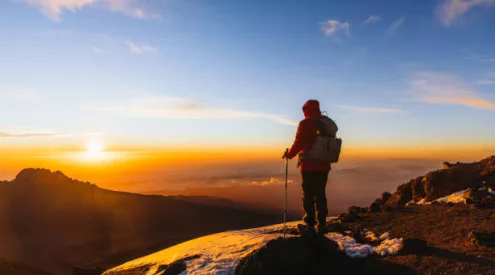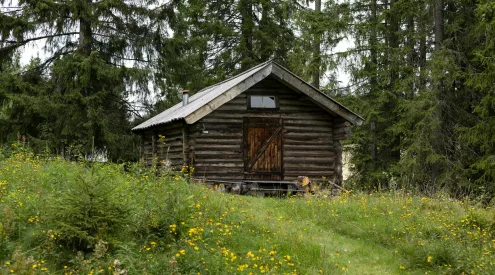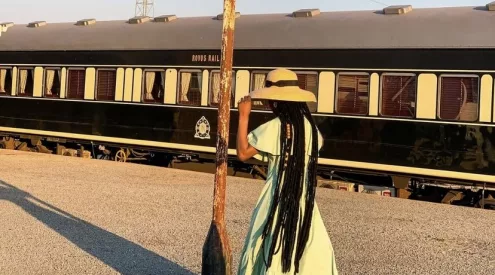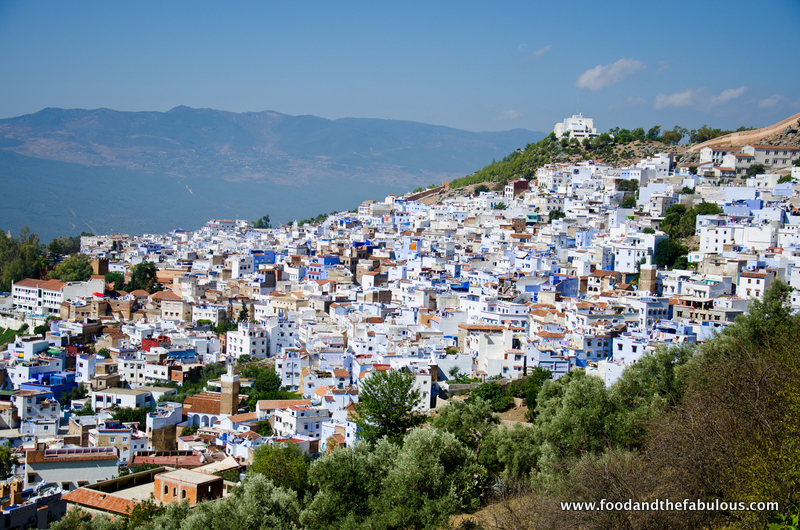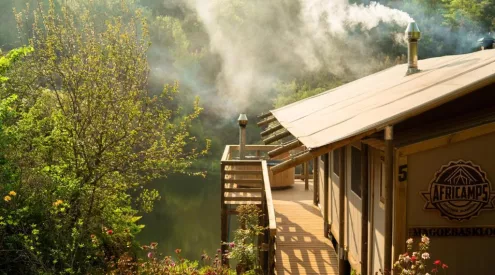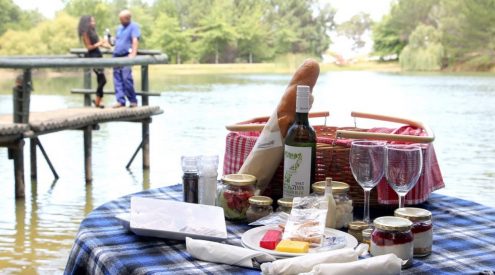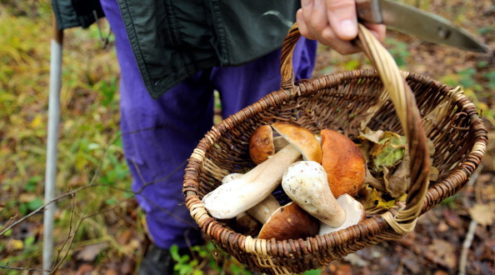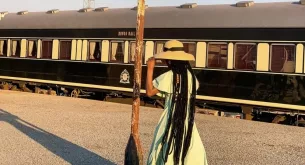She turns her face around abruptly, I see deep lines etched into her skin. I’m surprised by its paleness. A straw hat like a pyramid sits atop her head, grey hair in a braid. She tugs at the mule’s reigns and turns away. The mule, packed with prickly pears and vegetables from the old woman’s garden in the mountains moves forward with his cargo dutifully. Her skirt of vivid red and white stripes is a strangely hypnotic sight against the sharp edges of the hills as the pair continue their descent into the next town. I follow the red-and-white with my eyes for a few more minutes, the shape diminishing as I blink, like some desert-induced trick, except we aren’t in the desert. We are at the foot of the Rif Mountains.
Our refreshment break is over. I note that Abdou, our driver, is shifting his weigh awkwardly, eager to get a move on. It’s been a pleasant but taxing few hours from Meknes. The tarred roads are evidence of development in Morocco’s infrastructure, but they twist and turn, sometimes jarring the body uncomfortably with sudden bumps. And it is hot. Thirty degrees Celcius. Abdou keeps the windows open instead of using the air conditioner, I’m not certain this is the best method to remain cool but he’s in charge and I don’t think he’d appreciate instructions from a foreigner. Later that day, after a late lunch in Chefchaouen, the hilly city where houses are washed in a pale blue paint, I see women in red striped skirts on mules, heading back towards the mountains.
Is she with them, I wonder.
A brief guide to Chefchaouen

Chefchaouen in northern Morocco, close to the popular port of Tangier, is named as such because a mountain range above the city that looks like two chaouen or goat’s ‘horns’. The city lies between the horns. Chefchaouen was built by Spanish exiles as a fortress against in Portuguese in 1471, who were as you will know still ruthless, powerful kings of the sea at the time.
A ‘typical’ Moroccan city. Really?

Guidebooks mention that Chefchaouen is the ‘typically’ Moroccan that tourists crave. I’m not sure what that means, exactly. On our previous visit to Morocco we sought out the seclusion of the Berber Ourika Valley as well as the hustle of its most famous modern city, Marrakech. I’m not sure what the typical is that tourists would seek in Chefchaouen. Every town and city, while retaining essential similarities such as the structure of life in the medinas, the central position occupied by the mosque in the life of a Muslim, the melodic call of the imam echoing through the streets and valleys five times a day, a general aversion to alcohol and the serving thereof (naturally) and the presence of traders and craftsmen, has a layout and terrain that is different. In fact within 20 kilometers of each area you can go from coast line to lush forests, barren, sandy multi-hued hills, cactus in thick shrouds and so on.
With its pale blue houses and buildings (painted as such as a result of a pact we were told, between Arab (white) and Jew (dark blue), the buildings are painted in this hue twice a year), Andalusian style red terracotta roof tiles and rugged mountainous landscapes Chefchaouen is unique, more than it is typical. Perhaps it’s the Moroccan city as we see depicted in Disney animations and in our dreams. It’s more than pretty. It’s perfect, in fact.

Hashish, anyone?
Chefchaouen is an easy city to visit. Relaxed. Some of the young local men wear short pants, the vivid red stripes of the berber cloths worn by the mountain women draw and hold the gaze. The city is hilly and the pace is slow. A thin river snakes through it.
Oh, and it’s a well known fact that visitors come here to smoke a special kind of marijuana and ‘think about life’ in the words of our guide.
A holiday feeling

Because you can see the expanse of the city when you hike up the nearby hills or from various steep-sloped streets, you get the feeling of knowing and understanding the breadth of it, more easily. Opposed to say, Fes or flat as a straight-hair-on-a-limp-day Marrakech where the medina is a labyrinth and you can not see beyond one narrow alley at a time and certainly have no readily available vantage point to scope out the extent of the city.
Sitting by a brook, sipping the ubiquitous Moroccan mint tea, I smiled at Jelle who was dressed in shorts (and not feeling like a pesky tourist, as many locals dressed in the same manner) and I knew what he would say when asked “Is this your favourite?”

The Blue City gives you the calm holiday feeling a visit to Kerala (or Cape Town) would after a visit to Mumbai/New Delhi (or Johannesberg). No roadside vendors lopping the top off fresh coconuts, but you get the idea.
Your wife has a black heart
It’s relaxed, the vendors and traders are less aggressive (and prices more reasonable, in my opinion). Don’t get me wrong, I never felt hassled in Morocco. But, shopping and bargaining can be a draining exercise.
You choose to look, with the option to buy and you can choose to walk away from the emotional manipulation, such as “For a wife this beautiful, I wouldn’t even blink an eye. I would pay whatever I was asked for anything she wanted” to “Your wife has a black heart”. This was said to an elderly British couple who stayed at our riad in Fes. Frequent visitors to Morocco, the wife just wanted to ask questions about the leather and textiles but had no intention to buy.
I’m not a great bargainer. I feel awkward. I feel sympathetic. I never want to be the looks-but-doesn’t-buy wife with the black heart.
Sigh.
Chefchaouen top tips: where to stay, eat and shop
Three days would be nice in Chefchaouen, longer would be better as you can visit the mountain villages or nearby forests with a guide and sleep out.
We stayed at Casa Hasan, well at the sister riad a few meters down. It’s quieter but service is not the friendliest we encountered in Morocco. But, sometimes you don’t want to have to go through the motions of long greetings exchanged with staff, especially after a few weeks on the go. So we weren’t too bothered by the silence. It is quite well appointed and if you ask why it isn’t number 1 or 2 on Tripadvisor, well…. Chefchaouen is a frequented by a slew of backpackers, the cheaper spots will find a higher ranking, naturally.
 Explore the medina and visit the traders. It’s much easier to do than the bigger cities and harder to get lost. If you’re looking for the Berber cloths the women from the mountains wear as skirts, buy these from the Women’s Cooperative store at the market – not expensive (around 50 dirham each) and the quality is good. Or buy from a variety of vendors, your choice. Use as tablecloths, or in my case: food styling props.
Explore the medina and visit the traders. It’s much easier to do than the bigger cities and harder to get lost. If you’re looking for the Berber cloths the women from the mountains wear as skirts, buy these from the Women’s Cooperative store at the market – not expensive (around 50 dirham each) and the quality is good. Or buy from a variety of vendors, your choice. Use as tablecloths, or in my case: food styling props.
- Walk down the road from the Parador (as if exiting town). Soon enough you will come to a restaurant called Chez Aziz (fab reviews on Tripadvisor, not that that counts. But still). Yes, they advertise pizza. But, their baked goods and snacks are fantastic; if you’re suffering tagine fatigue this is your mecca. Also cheap as chips. R12 for a wrap or burger, made freshly in front of you. Insider tip: the locals order a thick pistachio-green milkshake called ‘zaazaa’. It contains, I figure avo, kiwi, cream, banana slices, custard (I honestly thought it was flavourless egg white slices), topped with cream. I know it sounds bizarre. It was worth trying, promise. Share one between two if not ravenous post savoury course and skip dessert.
- Having Chefchaouen as your last destination before you exit Morocco is highly recommended. You will have to get to Casablanca to exit via the airport, but you can calculate that into the occasional (read often) inconvenience of travel.
- For all the reports about abundant pot/hashish/Mary-Jane, I have no clue where you can find any. Sorry, friends.

